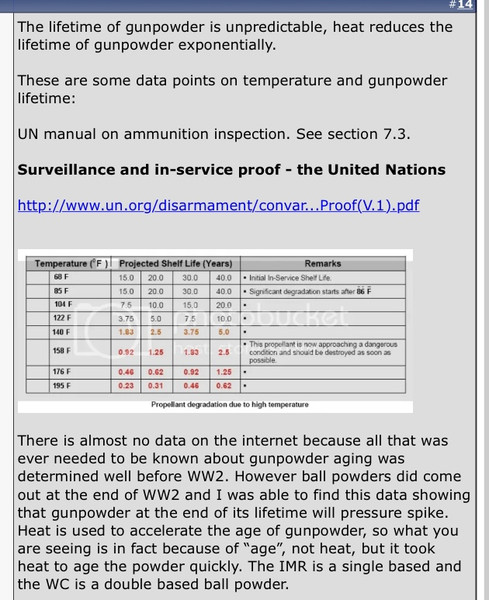I lived in central valley of California (Sacramento area) all my life. It's a very warm climate, to say the least. This made propellant storage a no-brainer. It must remain inside the air-conditioned confines of the house.
March this year, my wife and I escaped Kalifornia to the freedom of the great state of Idaho and moved into a newly built home. The climate here is much cooler . To my surprise, there was a little room, accessed from the garage, that is a small storage area below the stairwell inside the house. I call it the "garage pantry" - for lack of a better name. The instant I saw it, I knew that's where I'm going to store my powder; and did so.
. To my surprise, there was a little room, accessed from the garage, that is a small storage area below the stairwell inside the house. I call it the "garage pantry" - for lack of a better name. The instant I saw it, I knew that's where I'm going to store my powder; and did so.
I keep a thermometer in there and monitor it frequently. As it turns out, in the summer it gets a bit warm in there - approaching 80 degrees. So I thought it best to move the powder in the house - where it's a constant 76 degrees. Now that the cool months have rolled back around, I'm keeping the powder back in the garage pantry again.
At night, the outside air temp has been dropping deep into the teens (f). The garage itself is running in the very low 40's, creeping up to about 50 during the warmest part of the day. The garage pantry is 55 degrees during the coldest time of day, creeping up to about 62 in the afternoon.
And that's the real question: Is this temperature fluctuation at cooler temps better of worse for the powder than a constant warmer temp?
March this year, my wife and I escaped Kalifornia to the freedom of the great state of Idaho and moved into a newly built home. The climate here is much cooler
I keep a thermometer in there and monitor it frequently. As it turns out, in the summer it gets a bit warm in there - approaching 80 degrees. So I thought it best to move the powder in the house - where it's a constant 76 degrees. Now that the cool months have rolled back around, I'm keeping the powder back in the garage pantry again.
At night, the outside air temp has been dropping deep into the teens (f). The garage itself is running in the very low 40's, creeping up to about 50 during the warmest part of the day. The garage pantry is 55 degrees during the coldest time of day, creeping up to about 62 in the afternoon.
And that's the real question: Is this temperature fluctuation at cooler temps better of worse for the powder than a constant warmer temp?

